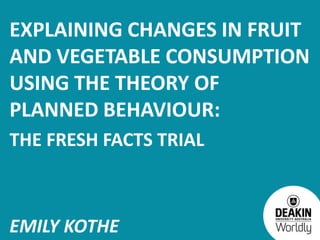Kothe - ASBHM - Explaining Changes In Fruit And Vegetable Consumption Using The Theory Of Planned Behaviour
•Als PPTX, PDF herunterladen•
1 gefällt mir•649 views
Explaining Changes In Fruit And Vegetable Consumption Using The Theory Of Planned Behaviour: The Fresh Facts Trial
Melden
Teilen
Melden
Teilen

Empfohlen
Empfohlen
Weitere ähnliche Inhalte
Ähnlich wie Kothe - ASBHM - Explaining Changes In Fruit And Vegetable Consumption Using The Theory Of Planned Behaviour
Ähnlich wie Kothe - ASBHM - Explaining Changes In Fruit And Vegetable Consumption Using The Theory Of Planned Behaviour (20)
Emily Kothe - ICBM2012 - Randomised controlled trial of a theory-based interv...

Emily Kothe - ICBM2012 - Randomised controlled trial of a theory-based interv...
Applying the Theories of Reasoned Action Planned Behavior.pdf

Applying the Theories of Reasoned Action Planned Behavior.pdf
Correlations between positive affect & fruit/veg intake

Correlations between positive affect & fruit/veg intake
Using Ecological Momentary Assessment to Examine Post-food Consumption Affect...

Using Ecological Momentary Assessment to Examine Post-food Consumption Affect...
Correlation between Eating Habits and Nutritional Status

Correlation between Eating Habits and Nutritional Status
Case StudyMrs. A is a 71 year old widow with CHF and osteoarthri

Case StudyMrs. A is a 71 year old widow with CHF and osteoarthri
Effects of Daily Consumption of Synbiotic Bread on Insulin Metabolism and Ser...

Effects of Daily Consumption of Synbiotic Bread on Insulin Metabolism and Ser...
Exploring Unobserved Heterogeneity of Food Safety Behavior: A Meta-Analysis

Exploring Unobserved Heterogeneity of Food Safety Behavior: A Meta-Analysis
Regulatory aspects of bioequivalence iss xr4-revised

Regulatory aspects of bioequivalence iss xr4-revised
Nutritional Knowledge of Students on Consumption of Vegetables and Fruits and...

Nutritional Knowledge of Students on Consumption of Vegetables and Fruits and...
Mehr von Emily Kothe
Mehr von Emily Kothe (6)
ASBHM - The role of habit in gluten free diet adherence - Kothe and Mullan 2014

ASBHM - The role of habit in gluten free diet adherence - Kothe and Mullan 2014
Freijy - ASBHM - Do interventions based on cognitive dissonance promote healt...

Freijy - ASBHM - Do interventions based on cognitive dissonance promote healt...
Kothe - ASBHM - Understanding the fruit and vegetable consumption behaviour o...

Kothe - ASBHM - Understanding the fruit and vegetable consumption behaviour o...
Mullan - BPS DHP - Interventions to Improve Breakfast Consumption

Mullan - BPS DHP - Interventions to Improve Breakfast Consumption
Amaratunga - Heart Foundation - IMPROVING NUTRITION USING A PSYCHOSOCIAL INTE...

Amaratunga - Heart Foundation - IMPROVING NUTRITION USING A PSYCHOSOCIAL INTE...
Kothe - ASBHM - Explaining Changes In Fruit And Vegetable Consumption Using The Theory Of Planned Behaviour
- 1. EXPLAINING CHANGES IN FRUIT AND VEGETABLE CONSUMPTION USING THE THEORY OF PLANNED BEHAVIOUR: THE FRESH FACTS TRIAL EMILY KOTHE
- 2. BACKGROUND oAustralian young adults are less likely than any other age group to consume adequate quantities of fruit and vegetables.1 oThe theory of planned behaviour has previously been found to predict a large proportion of the variance in intake in this population. 2,3,4 oTo determine whether change in fruit and vegetable consumption in the FreshFacts study could be explained by change in theory of planned behaviour cognitions
- 3. METHOD oUniversity undergraduates (N=162) completed a theory of planned behaviour intervention designed to increase fruit and vegetable intake. oParticipants were randomised to either the intervention or control conditions. oAll participants completed a theory of planned behaviour questionnaire and a self-report measure of fruit and vegetable consumption at baseline and immediate post- intervention follow-up (Day 30).
- 4. METHOD Baseline assessment (n=180) Control Intervention (n=90) (n=90) Follow-up assessment (n=162)
- 5. FRUIT AND VEG @ T1 • Theory of planned behaviour accounted for 24% of variance in fruit and vegetable intake at baseline. Attitude .42 .37 Fruit and Subjective Norm Intention vegetable intake Perceived behavioural control
- 6. FRUIT AND VEG @ T2 • Theory of planned behaviour accounted for 17% of variance in fruit and vegetable intake at follow-up. Attitude .40 .18 Fruit and Subjective Norm Intention vegetable intake Perceived behavioural control
- 7. CHANGE IN FRUIT AND VEG • Theory of planned behaviour accounted for just 2.3% of variance in change in fruit and vegetable consumption. Attitude .11 .03 Fruit and Subjective Norm Intention vegetable intake Perceived behavioural control
- 8. CONCLUSIONS oTheory of planned behaviour did not predict change in fruit and vegetable consumption oFailure of the theory to predict change in fruit and vegetable consumption may reflect artifacts of the study design. oHowever, these results are consist with other recent studies based on the theory.5
- 9. FUTURE DIRECTIONS oResearchers should not assume that theories that successfully predict behaviour (either cross-sectionally or prospectively) will adequately model change in behaviour. oMore research on the mediation of behaviour change through theory relevant pathways are needed to confirm or clarify these findings.